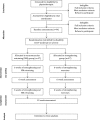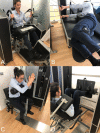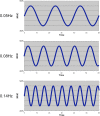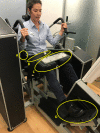Effects of lumbar extensor muscle strengthening and neuromuscular control retraining on disability in patients with chronic low back pain: a protocol for a randomised controlled trial
- PMID: 31431445
- PMCID: PMC6707707
- DOI: 10.1136/bmjopen-2018-028259
Effects of lumbar extensor muscle strengthening and neuromuscular control retraining on disability in patients with chronic low back pain: a protocol for a randomised controlled trial
Abstract
Introduction: Chronic low back pain (CLBP) is the leading cause of disability worldwide. However, there is no consensus in the literature regarding optimal management. Exercise intervention is the most widely used treatment as it likely influences contributing factors such as physical and psychological. Literature evaluating the effects of exercise on CLBP is often generalised, non-specific and employs inconsistent outcome measures. Moreover, the mechanisms behind exercise-related improvements are poorly understood. Recently, research has emerged identifying associations between neuromuscular-biomechanical impairments and CLBP-related disability. This information can be used as the basis for more specific and, potentially more efficacious exercise interventions for CLBP patients.
Methods and analysis: Ninety-four participants (including both males and females) with CLBP aged 18-65 who present for treatment to a Melbourne-based private physiotherapy practice will be recruited and randomised into one of two treatment groups. Following baseline assessment, participants will be randomly allocated to receive either: (i) strengthening exercises in combination with lumbar force accuracy training exercises or (ii) strengthening exercises alone. Participants will attend exercise sessions twice a week for 12 weeks, with assessments conducted at baseline, midway (ie, 6 weeks into the trial) and at trial completion. All exercise interventions will be supervised by a qualified physiotherapist trained in the intervention protocol. The primary outcome will be functional disability measured using the Oswestry Disability Index. Other psychosocial and mechanistic parameters will also be measured.
Ethics and dissemination: This study was given approval by the University of Melbourne Behavioural and Social Sciences Human Ethics Sub-Committee on 8 August 2017, reference number 1 749 845. Results of the randomised controlled trial will be published in peer-reviewed journals.
Trial registration number: ACTRN12618000894291.
Keywords: chronic pain; low back pain; musculoskeletal pain; rehabilitation exercise; resistance training.
© Author(s) (or their employer(s)) 2019. Re-use permitted under CC BY-NC. No commercial re-use. See rights and permissions. Published by BMJ.
Conflict of interest statement
Competing interests: None declared.
Figures





Similar articles
-
Effects of Traditional Chinese Exercise Yijinjing on Disability and Muscle Strength Among Patients With Chronic Low Back Pain: Protocol for a Randomized Controlled Trial.JMIR Res Protoc. 2025 May 7;14:e67557. doi: 10.2196/67557. JMIR Res Protoc. 2025. PMID: 40334269 Free PMC article.
-
Efficacy of sensorimotor training combined with core strength training for low back pain in adult idiopathic scoliosis: a study protocol for a randomized controlled trial.BMJ Open. 2025 May 23;15(5):e091476. doi: 10.1136/bmjopen-2024-091476. BMJ Open. 2025. PMID: 40409968 Free PMC article.
-
The efficacy of a multimodal physical activity intervention with supervised exercises, health coaching and an activity monitor on physical activity levels of patients with chronic, nonspecific low back pain (Physical Activity for Back Pain (PAyBACK) trial): study protocol for a randomised controlled trial.Trials. 2018 Jan 15;19(1):40. doi: 10.1186/s13063-017-2436-z. Trials. 2018. PMID: 29334992 Free PMC article.
-
A review of the clinical value of isolated lumbar extension resistance training for chronic low back pain.PM R. 2015 Feb;7(2):169-87. doi: 10.1016/j.pmrj.2014.10.009. Epub 2014 Oct 29. PM R. 2015. PMID: 25452128 Review.
-
The effectiveness of different aerobic exercises to improve pain intensity and disability in chronic low back pain patients: a systematic review.F1000Res. 2023 Jul 18;11:136. doi: 10.12688/f1000research.75440.2. eCollection 2022. F1000Res. 2023. PMID: 37854288 Free PMC article.
Cited by
-
Thoracolumbar Slope Is Useful Parameter for Evaluating HealthRelated Quality of Life and Sagittal Imbalance Aggravation in Adult Spinal Deformity: A Prospective Observational Cohort Study.Neurospine. 2021 Sep;18(3):467-474. doi: 10.14245/ns.2142408.204. Epub 2021 Sep 30. Neurospine. 2021. PMID: 34610676 Free PMC article.
-
Machine Learning Derived Lifting Techniques and Pain Self-Efficacy in People with Chronic Low Back Pain.Sensors (Basel). 2022 Sep 4;22(17):6694. doi: 10.3390/s22176694. Sensors (Basel). 2022. PMID: 36081153 Free PMC article.
-
Reliability of lumbar multifidus and iliocostalis lumborum thickness and echogenicity measurements using ultrasound imaging.Australas J Ultrasound Med. 2021 Jun 23;24(3):151-160. doi: 10.1002/ajum.12273. eCollection 2021 Aug. Australas J Ultrasound Med. 2021. PMID: 34765425 Free PMC article.
-
Electromyography of the Multifidus Muscle in Horses Trotting During Therapeutic Exercises.Front Vet Sci. 2022 May 27;9:844776. doi: 10.3389/fvets.2022.844776. eCollection 2022. Front Vet Sci. 2022. PMID: 35692292 Free PMC article.
-
Impaired Lumbar Extensor Force Control Is Associated with Increased Lifting Knee Velocity in People with Chronic Low-Back Pain.Sensors (Basel). 2023 Oct 31;23(21):8855. doi: 10.3390/s23218855. Sensors (Basel). 2023. PMID: 37960555 Free PMC article.
References
-
- Vos T, Allen C, Arora M, et al. . Global, regional, and national incidence, prevalence, and years lived with disability for 310 diseases and injuries, 1990–2015: a systematic analysis for the global burden of disease study 2015. The Lancet 2016;388:1545–602. 10.1016/S0140-6736(16)31678-6 - DOI - PMC - PubMed
Publication types
MeSH terms
Associated data
LinkOut - more resources
Full Text Sources
